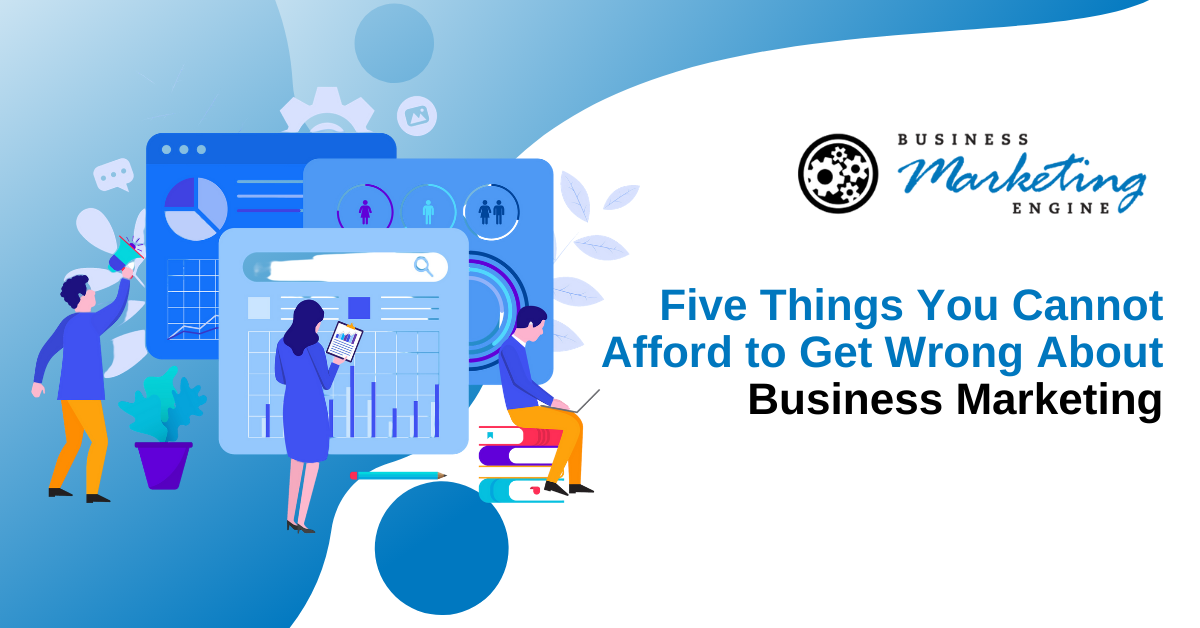As a business owner, you already understand the value of marketing. However, understanding its importance and implementing a successful business marketing strategy are two different concepts. Entrepreneurs who wind up making mistakes along the way end up hurting their bottom line.
Although experience can be the best teacher, you likely do not have the budget to “learn on the go.” Thankfully, we have compiled a list of the top five marketing elements that you should focus on the most. Once you have mastered these, your success is almost guaranteed.
Mistaking Advertising for Marketing
Advertising and marketing go hand in hand. However, they are distinct components that must work together to build your brand. Here is a quick overview of the difference between them.
Advertising consists of promoting your products or services or the business as a whole. The goal of advertising is to raise awareness of your offerings. Whether you sell back massages, dog food or children’s toys, ads will let people know what your company offers.
Marketing is much more comprehensive. Rather than focusing on specific products or services, your marketing should address the customer’s needs and wants. If advertising is the “what” of your brand, marketing is the “why.”
Overall, it is not enough to simply show off your products — you need to help your customers understand why they should buy them from you. Ads can reflect your marketing strategy, but there has to be more going on behind the scenes. While each company is unique, some of the core components of any marketing strategy should include:
- Unique Value Proposition – What will customers get from your business that they cannot find elsewhere? Is it a better service? Better products? A combination of several factors?
- Customer Journey – Rarely will a person interact with your business once before buying. Usually, there are multiple “touchpoints” that will lead to a sale. If you do not know what these points are, you cannot address specific concerns or needs along the way.
- Mission Statement – What is the goal of your business beyond making money? How do you hope to improve the lives of your customers?
While it makes sense to invest in eye-popping ads, there has to be a reason behind them. In the old days, advertisements tried to reach as many people as possible. However, with the market so segmented in modern times, this approach is no longer feasible. You have to get creative.
Identifying and Connecting With Your Audience
One substantial side effect of the internet is that it has never been easier to reach targeted demographics. Traditional advertising methods like radio and television are no longer the juggernauts they used to be. Since customers can be on multiple platforms like social media and search engines, companies have to spread their message more selectively.
Before taking a “shotgun” approach to marketing, it is far better to understand your core audience. Who will benefit the most from your products or services? What makes your brand stand out from the competition? What can you deliver that other companies cannot?
When answering these questions, you have to think from the perspective of your ideal customer. The more you can understand your audience, the easier it is to tailor your messaging to satisfy them. Here are two ways to get into the mindset of your target demographics.
Develop Customer Personas
Rather than trying to reach a broad spectrum of people, it helps to focus your attention on a single individual. For example, instead of targeting single moms, you can market to Pamela, who has two children and works part-time. By fleshing out Pamela’s backstory and needs, you can determine your marketing campaign’s best route.
Conduct Market Research
One problem that many business owners have is that they make assumptions about their customers. However, these assumptions can often be incorrect, which can turn into a disaster. It is never advisable to build a campaign on a hunch.
Instead, gather factual data about your target demographics. What are their values? What brands do they like? Why do they like those brands? What kind of platforms do they use? How active are they within these platforms?
The more information you can gather about your potential customers, the easier it is to build a campaign to speak to their individual needs.
Being Authentic With Your Marketing
Consumers these days are far savvier than in years past. That means most individuals get turned off by traditional “sales speak.” In many cases, a person can tell when you are delivering a canned pitch and they are far more likely to go elsewhere when you do.
But why is that the case? On some level, consumers understand that businesses have to make money. They turn away from advertisements because of a lack of authenticity, among other reasons.
According to a recent study, 90 percent of respondents said that authenticity was the most important factor when choosing the brands they like. That statistic is only trending upward since it was at 86 percent in 2017.
But, what does authenticity mean for your business? Here are some strategies:
- Tell a Story – Humans are naturally drawn to stories because they are engaging. All stories have a beginning, middle, and end, and the best tales are ones that have some kind of arc. Your business has a story; your customers have stories. Tap into them to deliver a much more compelling message.
- Focus on Value, Not Money – One surefire way to seem inauthentic is if it looks like money is your primary motive. This is why developing a strong mission statement is so vital for success. Of course, you want your business to be profitable, but to what end? Are you giving back to the community? Are you helping your customers live better lives? Show off the value of your brand, and the results will follow.
- Be Transparent – While you do not necessarily have to “show how the sausage is made,” you should give some insight into what’s going on behind the scenes. What is it like to work for your company? Who is on the management team? Adding a face to the brand can make it seem much more approachable and authentic.
Staying Focused and Consistent
Another significant problem that business owners will run into is that they try too many tactics at once. Usually, this practice involves throwing a bunch of ideas out there until one of them sticks. Unfortunately, marketing is a marathon, not a sprint.
Here is where market research and customer personas can really pay off. It also helps to have a much more conservative mindset of success for a specific campaign. If you are hoping to build an audience and increase sales substantially within a month, you will be sorely disappointed.
While change can be good, it needs to happen much slower than you might think. Even if your current campaign is going strong, there is no need to switch gears. Unless you are reaching 100 percent of the market, there is always the potential for growth.
Follow these guidelines when rolling out a new marketing campaign:
- Start Small – Whatever metrics you are trying to achieve (i.e., increased website traffic, fewer abandoned carts), you don’t want to bite off more than you can chew. Start with small benchmarks and see how easy they are to reach. You can always go higher.
- Conduct Check-Ins – If your campaign runs for three months, check in with your marketing team monthly to see how well it is going. These check-ins can help you temper your expectations or allow you to refine your message based on feedback.
- Keep it Simple – If you had to define your campaign in three words or less, what would they be? Your message has to be clear, concise and actionable. If your marketing is too complicated, it can be confusing for your customers.
Analyzing and Refining
One of the primary reasons businesses keep switching their marketing tactics is that they don’t know what is working and what isn’t. Without a system to analyze results and compile data, there is no way to ensure long-term success.
Data analysis is crucial for marketing because it can help you refine your message and invest more resources into campaigns that work. Why waste time and energy on advertising that does not deliver? Here are some ways to analyze your marketing:
- A/B Testing – Run two versions of the same ad (or landing page) and see which one generates more results.
- Data Capture – Sites like Google and Facebook can give you tons of information on your customers and campaigns. Use these tools to your advantage.
- Surveys – Sometimes, the best method is the most direct. Ask your customers what they like most about your marketing and see how it can be improved.
Let Business Marketing Engine Help Your Brand
If you want your marketing to be successful, you can’t do it all yourself. Not only do you not have the time to invest in it correctly, but you might not have the tools or resources to implement these strategies. Fortunately, Business Marketing Engine has everything you need to build your brand the right way. Call us today to find out how to get started.




